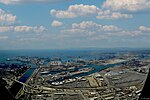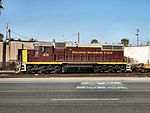Commodore Schuyler F. Heim Bridge

The Commodore Schuyler F. Heim Bridge was a vertical-lift bridge in the Port of Los Angeles. Dedicated on January 10, 1948, the bridge allowed State Route 47 (the Terminal Island Freeway) to cross over the Cerritos Channel. Named after Schuyler F. Heim, who was in command of the Naval Air Station on Terminal Island in 1942, the bridge was one of the largest vertical-lift bridges on the West Coast. At the time of its opening, it was the highest in the country with the deck weighing about 820 short tons (740 metric tons). Its towers are 186 feet (57 m) tall above the roadway deck and about 236 feet (72 m) tall when measured from the water level at high water. The bridge was decommissioned on October 12, 2015 and replaced by a new, six-lane fixed-span bridge in order to meet current safety and earthquake standards. A replacement bridge, tentatively titled State Route 47 Schuyler Heim Bridge Replacement, was completed in September 2020.
Excerpt from the Wikipedia article Commodore Schuyler F. Heim Bridge (License: CC BY-SA 3.0, Authors, Images).Commodore Schuyler F. Heim Bridge
Commodore Schuyler F. Heim Bridge, Long Beach
Geographical coordinates (GPS) Address External links Nearby Places Show on map
Geographical coordinates (GPS)
| Latitude | Longitude |
|---|---|
| N 33.766111 ° | E -118.239722 ° |
Address
Commodore Schuyler F. Heim Bridge
Commodore Schuyler F. Heim Bridge
90831 Long Beach
California, United States
Open on Google Maps










